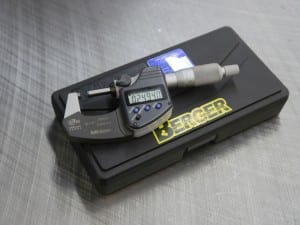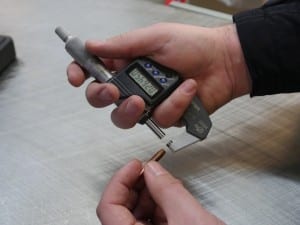 Outside micrometers can measure the diameter of a round object such as a cartridge case to check for excessive load pressure, cartridge case neck outside diameter if turning case necks, and outside diameter of the case neck of a loaded round so you can figure what neck bushing size to use if using bushing style, neck, full length or bump die. Inside micrometers such as “tubing micrometers” have a special round anvil so you can measure cartridge case neck wall thickness accurately because of the round anvil making proper contact with the inside radius of the neck wall.
Outside micrometers can measure the diameter of a round object such as a cartridge case to check for excessive load pressure, cartridge case neck outside diameter if turning case necks, and outside diameter of the case neck of a loaded round so you can figure what neck bushing size to use if using bushing style, neck, full length or bump die. Inside micrometers such as “tubing micrometers” have a special round anvil so you can measure cartridge case neck wall thickness accurately because of the round anvil making proper contact with the inside radius of the neck wall.
Before using your micrometer, check the face of the spindle and anvil to make sure they are in alignment and that the faces are flat. Lightly clamp a clean sheet of paper between the faces then pull it out to remove any oil or dust, then close the micrometer gently and check the thimble to see if the zero line on the spindle and thimble coincide.
 To use your micrometer, hold the work piece (case, bullet comparator, etc.) in your left hand and the micrometer in your right hand. Place the frame of the micrometer in the palm of the hand with your index finger and thumb gripping the knurled surface of the thimble. The ring finger holding the center of the frame and the little finger set inside the frame. Place the item you are measuring in position on the anvil and rotate the thimble between your thumb and fore finger until it is slightly clamped between the anvil and the spindle. Make sure you keep the item you are measuring aligned properly between the anvil and spindle while doing this. If your micrometer doesn’t have a friction thimble or ratchet, you will need to learn the “feel” to get a consistent, accurate measurement.
To use your micrometer, hold the work piece (case, bullet comparator, etc.) in your left hand and the micrometer in your right hand. Place the frame of the micrometer in the palm of the hand with your index finger and thumb gripping the knurled surface of the thimble. The ring finger holding the center of the frame and the little finger set inside the frame. Place the item you are measuring in position on the anvil and rotate the thimble between your thumb and fore finger until it is slightly clamped between the anvil and the spindle. Make sure you keep the item you are measuring aligned properly between the anvil and spindle while doing this. If your micrometer doesn’t have a friction thimble or ratchet, you will need to learn the “feel” to get a consistent, accurate measurement.
Make sure not to apply too much pressure to the object being measured, as it will give you a false reading and could even possibly spring the micrometers frame or strip the threads of the spindle. Rapid opening and closing of the spindle by “twirling” the frame to move the spindle can also damage its threads. When opening or closing your micrometer over a long range of movement, you should roll the thimble on your forearm or the palm of your hand.
Once you are finished with your micrometer, wipe it down with an oily cloth and add a drop of “Tool and instrument” oil on the threads. Make sure to store your micrometer in a clean safe place, such as the box it came in or your tool box. Never stack micrometers on top of each other.
Phil Hoham
Technical Specialist
Berger Bullets
Contact our Tech Support Team:
M-F 8am-4:30pm EST
Phone: 660-460-2800
Fax: 660-460-2801
support@capstonepg.com